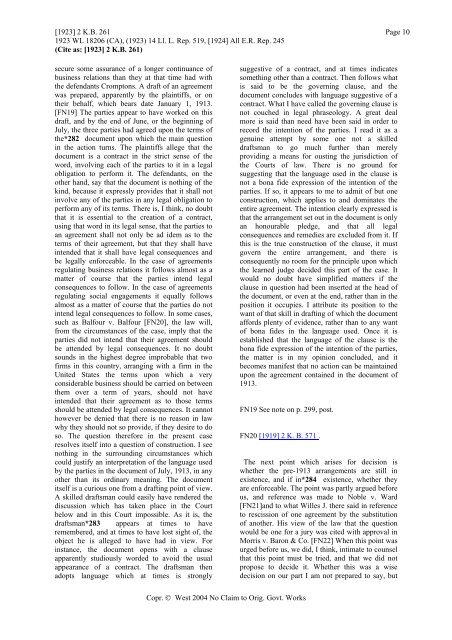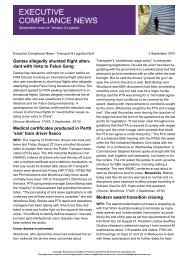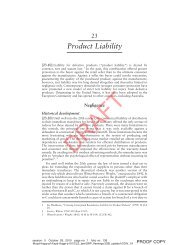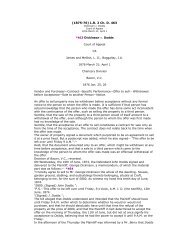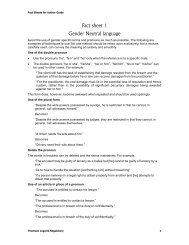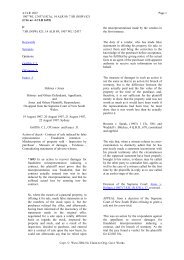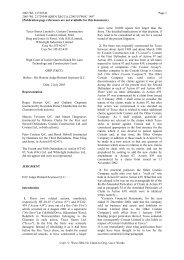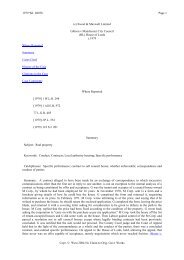Rose - Thomson Reuters
Rose - Thomson Reuters
Rose - Thomson Reuters
You also want an ePaper? Increase the reach of your titles
YUMPU automatically turns print PDFs into web optimized ePapers that Google loves.
[1923] 2 K.B. 261 Page 101923 WL 18206 (CA), (1923) 14 Ll. L. Rep. 519, [1924] All E.R. Rep. 245(Cite as: [1923] 2 K.B. 261)secure some assurance of a longer continuance ofbusiness relations than they at that time had withthe defendants Cromptons. A draft of an agreementwas prepared, apparently by the plaintiffs, or ontheir behalf, which bears date January 1, 1913.[FN19] The parties appear to have worked on thisdraft, and by the end of June, or the beginning ofJuly, the three parties had agreed upon the terms ofthe*282 document upon which the main questionin the action turns. The plaintiffs allege that thedocument is a contract in the strict sense of theword, involving each of the parties to it in a legalobligation to perform it. The defendants, on theother hand, say that the document is nothing of thekind, because it expressly provides that it shall notinvolve any of the parties in any legal obligation toperform any of its terms. There is, I think, no doubtthat it is essential to the creation of a contract,using that word in its legal sense, that the parties toan agreement shall not only be ad idem as to theterms of their agreement, but that they shall haveintended that it shall have legal consequences andbe legally enforceable. In the case of agreementsregulating business relations it follows almost as amatter of course that the parties intend legalconsequences to follow. In the case of agreementsregulating social engagements it equally followsalmost as a matter of course that the parties do notintend legal consequences to follow. In some cases,such as Balfour v. Balfour [FN20], the law will,from the circumstances of the case, imply that theparties did not intend that their agreement shouldbe attended by legal consequences. It no doubtsounds in the highest degree improbable that twofirms in this country, arranging with a firm in theUnited States the terms upon which a veryconsiderable business should be carried on betweenthem over a term of years, should not haveintended that their agreement as to those termsshould be attended by legal consequences. It cannothowever be denied that there is no reason in lawwhy they should not so provide, if they desire to doso. The question therefore in the present caseresolves itself into a question of construction. I seenothing in the surrounding circumstances whichcould justify an interpretation of the language usedby the parties in the document of July, 1913, in anyother than its ordinary meaning. The documentitself is a curious one from a drafting point of view.A skilled draftsman could easily have rendered thediscussion which has taken place in the Courtbelow and in this Court impossible. As it is, thedraftsman*283 appears at times to haveremembered, and at times to have lost sight of, theobject he is alleged to have had in view. Forinstance, the document opens with a clauseapparently studiously worded to avoid the usualappearance of a contract. The draftsman thenadopts language which at times is stronglysuggestive of a contract, and at times indicatessomething other than a contract. Then follows whatis said to be the governing clause, and thedocument concludes with language suggestive of acontract. What I have called the governing clause isnot couched in legal phraseology. A great dealmore is said than need have been said in order torecord the intention of the parties. I read it as agenuine attempt by some one not a skilleddraftsman to go much further than merelyproviding a means for ousting the jurisdiction ofthe Courts of law. There is no ground forsuggesting that the language used in the clause isnot a bona fide expression of the intention of theparties. If so, it appears to me to admit of but oneconstruction, which applies to and dominates theentire agreement. The intention clearly expressed isthat the arrangement set out in the document is onlyan honourable pledge, and that all legalconsequences and remedies are excluded from it. Ifthis is the true construction of the clause, it mustgovern the entire arrangement, and there isconsequently no room for the principle upon whichthe learned judge decided this part of the case. Itwould no doubt have simplified matters if theclause in question had been inserted at the head ofthe document, or even at the end, rather than in theposition it occupies. I attribute its position to thewant of that skill in drafting of which the documentaffords plenty of evidence, rather than to any wantof bona fides in the language used. Once it isestablished that the language of the clause is thebona fide expression of the intention of the parties,the matter is in my opinion concluded, and itbecomes manifest that no action can be maintainedupon the agreement contained in the document of1913.FN19 See note on p. 299, post.FN20 [1919] 2 K. B. 571 .The next point which arises for decision iswhether the pre-1913 arrangements are still inexistence, and if in*284 existence, whether theyare enforceable. The point was partly argued beforeus, and reference was made to Noble v. Ward[FN21]and to what Willes J. there said in referenceto rescission of one agreement by the substitutionof another. His view of the law that the questionwould be one for a jury was cited with approval inMorris v. Baron & Co. [FN22] When this point wasurged before us, we did, I think, intimate to counselthat this point must be tried, and that we did notpropose to decide it. Whether this was a wisedecision on our part I am not prepared to say, butCopr. © West 2004 No Claim to Orig. Govt. Works


